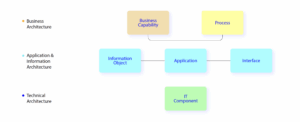In today’s fast-paced digital landscape, aligning long-term business strategies with tactical technology solutions is critical. However, the divide between Enterprise Architecture and Solution Architecture often creates challenges in achieving this alignment. That’s where EAXplorer comes in – empowering organizations to unify strategic vision and solution execution.
Understanding the Roles
To effectively bridge the gap, it is important to recognize the distinct but complementary roles that enterprise and solution architects play:
- Enterprise Architects
Focused on the long-term vision and strategic objectives, enterprise architects ensure that technology initiatives align with overarching business goals. - Solution Architects
Tasked with designing and implementing specific solutions, solution architects translate business requirements into practical technical architectures – often working closely with development teams.
Bridging the Gap: Key Practices
Bringing these two roles into alignment involves more than just organizational structure – it requires shared understanding, collaboration, and the right tools. Here are some best practices:
- Clear communication
Transparent and ongoing communication ensures that both EA and SA are aligned in objectives and expectations. - Shared Goals
Both roles should be oriented toward a unified mission: ensuring technology serves the business effectively and efficiently. - Cross-Functional Collaboration
Frequent collaboration helps to break down silos and encourages innovation through shared perspectives. - Unified Architectural Framework
Adopting a common architectural language – such as ArchiMate – and framework improves clarity and reduces miscommunication. - Gap Analysis
Regularly assessing the current state versus the desired state allows organizations to proactively address misalignments. - Solution Architects as Interpreters
Solution architects can play a critical role as intermediaries, translating business needs for technical teams and vice versa. - Continuous Feedback Loops
Establishing ongoing feedback between EA and SA ensures continuous improvement and adaptability to change. - Platform Engineering Principles
Implementing consistent platform engineering practices enables reuse and accelerates the alignment of individual solutions with enterprise-wide architecture.
How EAXplorer Helps
EAXplorer is specifically designed to bridge the gap between enterprise and solution architecture. Here is how:
- Unified Framework with TOGAF-Inspired Metamodel
EAXplorer’s repository is built around a TOGAF-inspired metamodel, ensuring consistent structure and strategic alignment across the organization. - Integrated ArchiMate-Compliant Modeling Tool
Model both enterprise and solution architectures within a single platform, facilitating clarity, traceability, and best-practice documentation. - Seamless Online Collaboration
With a fully integrated diagram tool and online repository, teams can collaborate in real time – ensuring alignment, transparency, and faster decision-making.
Conclusion
Bridging the gap between enterprise and solution architecture is no longer optional – it is essential for organizations that want to remain agile, efficient, and strategically aligned. With EAXplorer, you can empower your architecture teams to work as one, delivering value across the enterprise.
